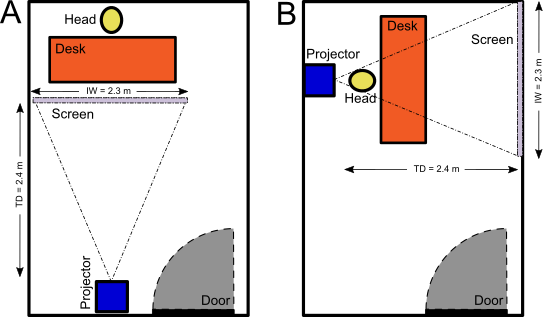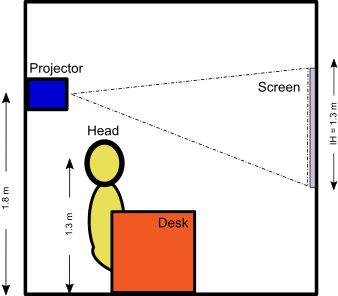So far, we have ignored practical constraints surrounding the placement of the PROPixx and the observer. We have not considered whether obstacles would prevent us from presenting an image in a direct line from the projector's lens.
In practice, using a rear projection screen is often the simplest projection solution. In this setup, the participant's eyes are typically directly in line with the mid-point of a projection screen (in both height and width). The projector is installed behind the screen, also projecting directly in line with the middle of the screen. We could choose a self-standing screen, or use a model that we can place directly on a desk. We could install the projector on a shelf at the same height (left-hand figure).
However, a drawback of rear projection installations is that the total space required is rather large. We often need more space when producing large images, which might become impractical in small rooms. In this case, you may want to consider a front projection screen. Here, we place the projector and the observer on the same side of the screen (right-hand figure).

In many experimental designs, observers view a visual display from 50 cm to 70 cm away, just as they would typically be seated in front of a computer monitor. However, in front projection, it is essential to carefully consider where you will be placing the projector. It is easy to overlook that the head of the observer, or even head-mounted recording apparatus, is likely to obstruct the projection path, thus casting disrupting shadows onto the screen. One standard solution is to set the projector on a shelf and lower the position of the image as low as the system affords it. This solution works well for seated participants. However, if the research design requires mounting hardware to the head of the participant, such as a neurophysiology rig on NHPs, then additional clearance must be considered. Depending on the constraints of the projection geometry, it is possible that the center of the image cannot be aligned with the observer's line of sight. This figure illustrates a successful wide-screen front-projection installation with a seated human subject, where eye-to-screen alignment was not critical and a large viewing distance was required as part of the research design.

The choice of rear vs front projection, as well as the specific screen material, significantly impact the characteristics of the projected image. To learn more about screen material, Stewart Filmscreen offers a great introduction to the topic.